Abstract
A possible role for C1q in antibody-dependent granulocyte-mediated killing of nonphagocytosable targets was investigated utilizing IgG-dependent granulocyte cytotoxicity directed against microfilariae of Dirofilaria immitis. Granulocyte-mediated killing of microfilariae is enhanced by addition of fresh serum. Lack of C4 did not significantly reduce the observed increase in cytotoxicity. The addition of highly purified monomeric human Clq (0.2 microgram/ml) in the presence of immune IgG resulted in a two- to fivefold enhancement of killing (P less than 0.025). C1q enhancement of killing occurred in the absence of fluid-phase IgG, but killing was significantly less than when both fluid-phase IgG and C1q were present. The effect of C1q was inhibited by the addition of solubilized type I collagen (44-92% inhibition of killing, P less than 0.05). Significant 125I-Clq binding to microfilariae occurred only in the presence of immune IgG. In addition, C1q in concentrations ranging from 0.5 to 2.0 micrograms/ml resulted in a dose-dependent increase in binding of 125I-immune IgG to microfilariae. Finally, when purified C1q was added to preopsonized, washed microfilariae, granulocyte production of superoxide was increased from 0.25 +/- 0.07 to 0.68 +/- 0.07 nm/10(6) cells.10 min (P less than 0.01). These results describe a novel functional role for C1q in enhancement of antibody-dependent cellular cytotoxicity towards nonphagocytosable targets.
Full text
PDF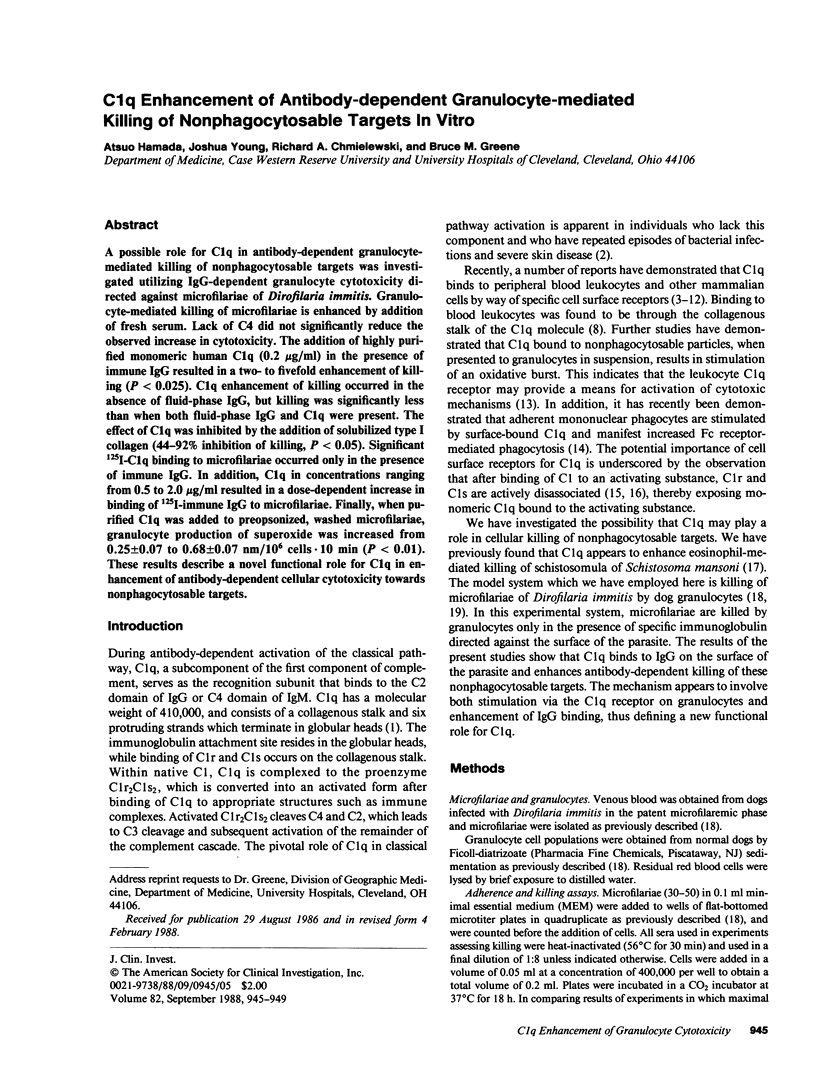
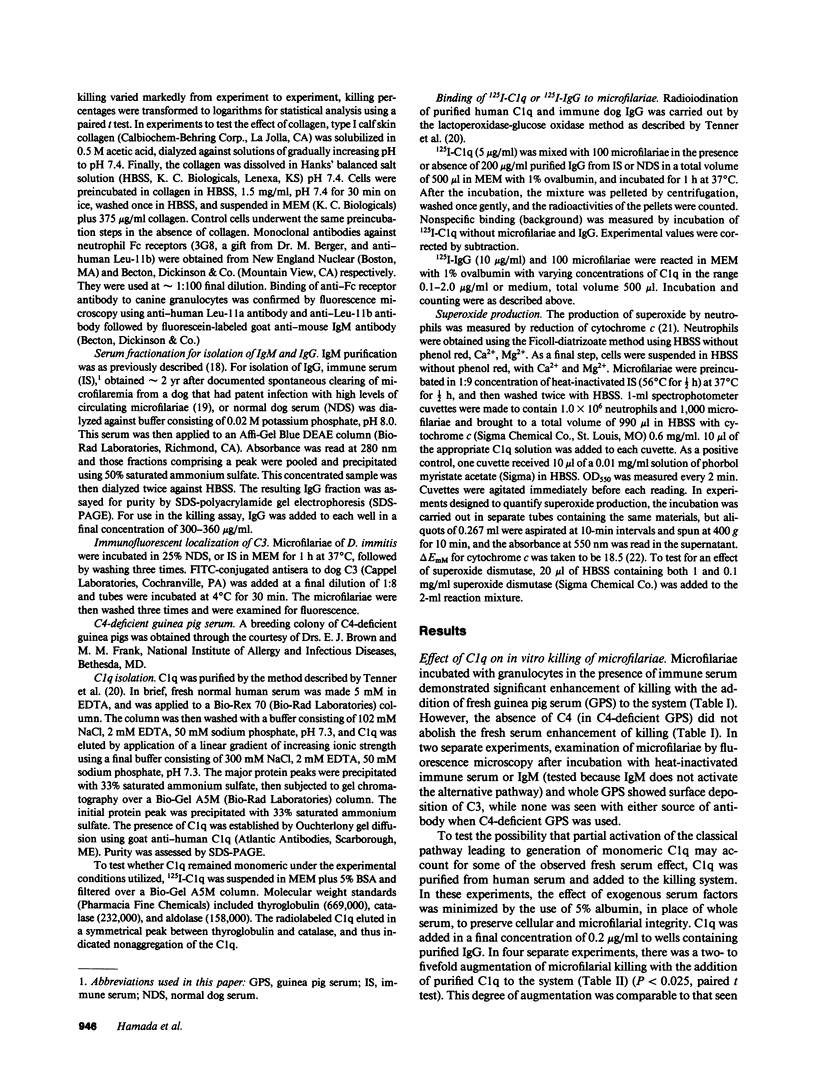
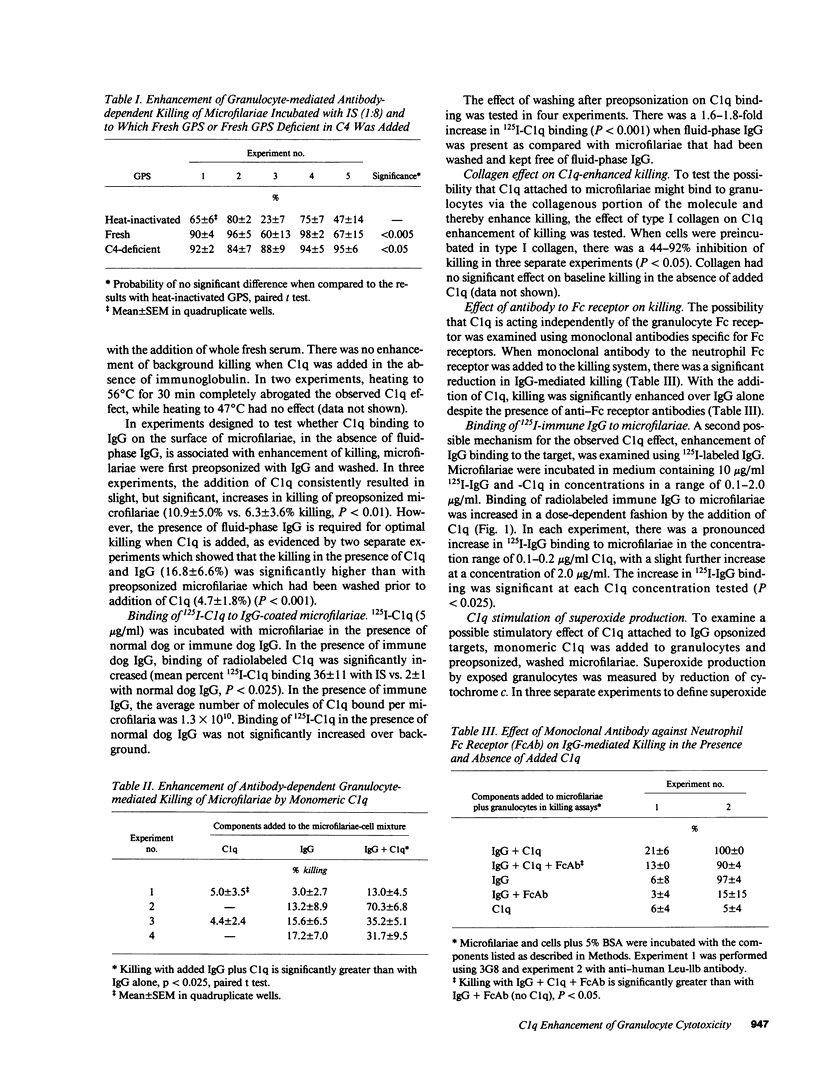
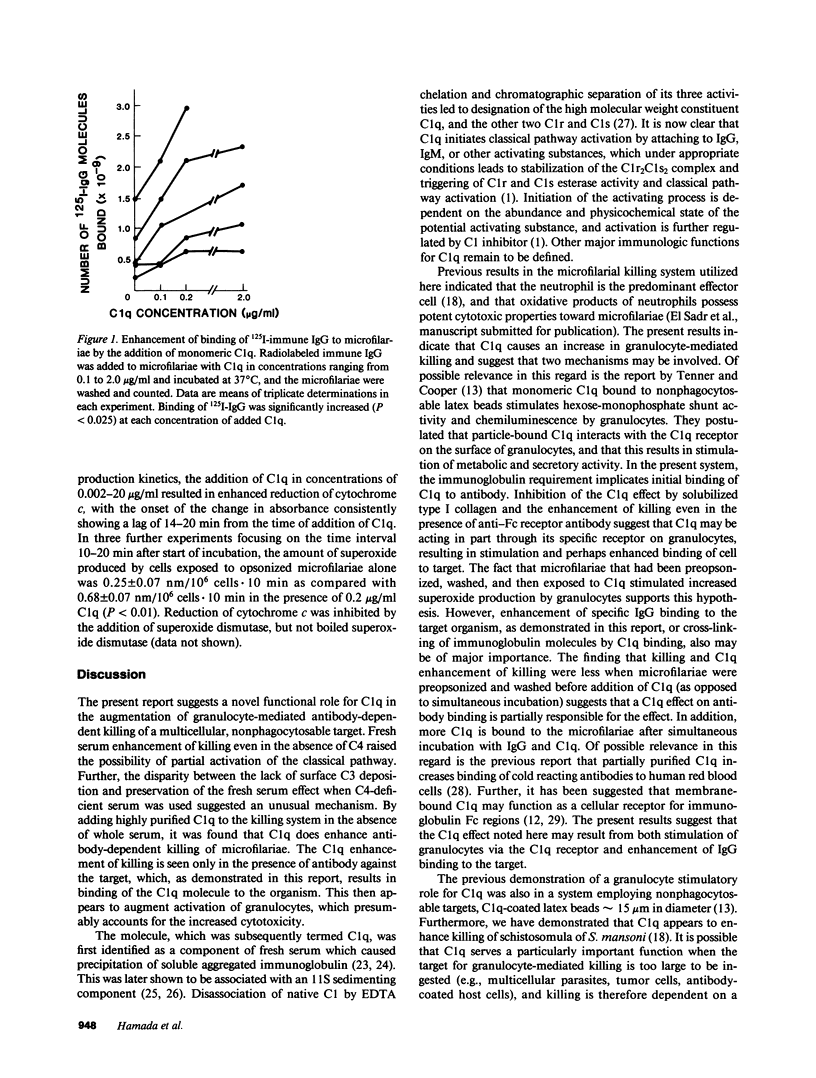
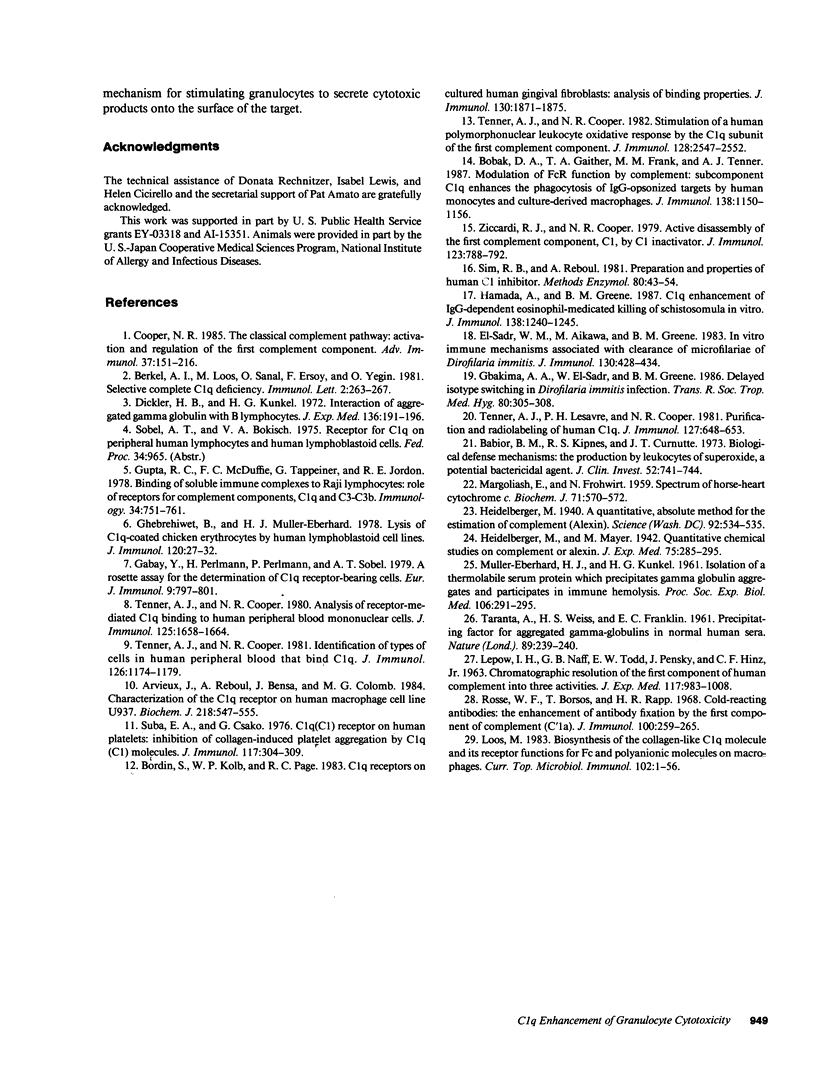
Selected References
These references are in PubMed. This may not be the complete list of references from this article.
- Arvieux J., Reboul A., Bensa J. C., Colomb M. G. Characterization of the C1q receptor on a human macrophage cell line, U937. Biochem J. 1984 Mar 1;218(2):547–555. doi: 10.1042/bj2180547. [DOI] [PMC free article] [PubMed] [Google Scholar]
- Babior B. M., Kipnes R. S., Curnutte J. T. Biological defense mechanisms. The production by leukocytes of superoxide, a potential bactericidal agent. J Clin Invest. 1973 Mar;52(3):741–744. doi: 10.1172/JCI107236. [DOI] [PMC free article] [PubMed] [Google Scholar]
- Bobak D. A., Gaither T. A., Frank M. M., Tenner A. J. Modulation of FcR function by complement: subcomponent C1q enhances the phagocytosis of IgG-opsonized targets by human monocytes and culture-derived macrophages. J Immunol. 1987 Feb 15;138(4):1150–1156. [PubMed] [Google Scholar]
- Bordin S., Kolb W. P., Page R. C. C1Q receptors on cultured human gingival fibroblasts: analysis of binding properties. J Immunol. 1983 Apr;130(4):1871–1875. [PubMed] [Google Scholar]
- Cooper N. R. The classical complement pathway: activation and regulation of the first complement component. Adv Immunol. 1985;37:151–216. doi: 10.1016/s0065-2776(08)60340-5. [DOI] [PubMed] [Google Scholar]
- Dickler H. B., Kunkel H. G. Interaction of aggregated -globulin with B lymphocytes. J Exp Med. 1972 Jul 1;136(1):191–196. doi: 10.1084/jem.136.1.191. [DOI] [PMC free article] [PubMed] [Google Scholar]
- El-Sadr W. M., Aikawa M., Greene B. M. In vitro immune mechanisms associated with clearance of microfilariae of Dirofilaria immitis. J Immunol. 1983 Jan;130(1):428–434. [PubMed] [Google Scholar]
- Gabay Y., Perlmann H., Perlmann P., Sobel A. T. A rosette assay for the determination of C 1 q receptor-bearing cells. Eur J Immunol. 1979 Oct;9(10):797–801. doi: 10.1002/eji.1830091010. [DOI] [PubMed] [Google Scholar]
- Gbakima A. A., el-Sadr W., Greene B. M. Delayed isotype switching in Dirofilaria immitis infection. Trans R Soc Trop Med Hyg. 1986;80(2):305–308. doi: 10.1016/0035-9203(86)90042-8. [DOI] [PubMed] [Google Scholar]
- Ghebrehiwet B., Müller-Eberhard H. J. Lysis of C1Q-coated chicken erythrocytes by human lymphoblastoid cell lines. J Immunol. 1978 Jan;120(1):27–32. [PubMed] [Google Scholar]
- Gupta R. C., McDuffie F. C., Tappeiner G., Jordon R. E. Binding of soluble immune complexes to Raji lymphocytes. Role of receptors for complement components, C1q and C3-C3b. Immunology. 1978 Apr;34(4):751–761. [PMC free article] [PubMed] [Google Scholar]
- Hamada A., Greene B. M. Clq enhancement of IgG-dependent eosinophil-mediated killing of schistosomula in vitro. J Immunol. 1987 Feb 15;138(4):1240–1245. [PubMed] [Google Scholar]
- Heidelberger M. A QUANTITATIVE, ABSOLUTE METHOD FOR THE ESTIMATION OF COMPLEMENT (ALEXIN). Science. 1940 Dec 6;92(2397):534–535. doi: 10.1126/science.92.2397.534. [DOI] [PubMed] [Google Scholar]
- LEPOW I. H., NAFF G. B., TODD E. W., PENSKY J., HINZ C. F. Chromatographic resolution of the first component of human complement into three activities. J Exp Med. 1963 Jun 1;117:983–1008. doi: 10.1084/jem.117.6.983. [DOI] [PMC free article] [PubMed] [Google Scholar]
- Loos M. Biosynthesis of the collagen-like C1q molecule and its receptor functions for Fc and polyanionic molecules on macrophages. Curr Top Microbiol Immunol. 1983;102:1–56. doi: 10.1007/978-3-642-68906-2_1. [DOI] [PubMed] [Google Scholar]
- MARGOLIASH E., FROHWIRT N. Spectrum of horse-heart cytochrome c. Biochem J. 1959 Mar;71(3):570–572. doi: 10.1042/bj0710570. [DOI] [PMC free article] [PubMed] [Google Scholar]
- MULLER-EBERHARD H. J., KUNKEL H. G. Isolation of a thermolabile serum protein which precipitates gamma-globulin aggregates and participates in immune hemolysis. Proc Soc Exp Biol Med. 1961 Feb;106:291–295. doi: 10.3181/00379727-106-26313. [DOI] [PubMed] [Google Scholar]
- Rosse W. F., Borsos T., Rapp H. J. Cold-reacting antibodies: the enhancement of antibody fixation by the first component of complement (C'1a). J Immunol. 1968 Feb;100(2):259–265. [PubMed] [Google Scholar]
- Sim R. B., Reboul A. Preparation and properties of human C1 inhibitor. Methods Enzymol. 1981;80(Pt 100):43–54. doi: 10.1016/s0076-6879(81)80007-9. [DOI] [PubMed] [Google Scholar]
- Suba E. A., Csako G. C1q (c1) receptor on human platelets: inhibition of collagen-induced platelet aggregation by C1q (C1) molecules. J Immunol. 1976 Jul;117(1):304–309. [PubMed] [Google Scholar]
- TARANTA A., WEISS H. S., FRANKLIN E. C. Precipitating factor for aggregated gamma-globulins in normal human sera. Nature. 1961 Jan 21;189:239–240. doi: 10.1038/189239a0. [DOI] [PubMed] [Google Scholar]
- Tenner A. J., Cooper N. R. Analysis of receptor-mediated C1q binding to human peripheral blood mononuclear cells. J Immunol. 1980 Oct;125(4):1658–1664. [PubMed] [Google Scholar]
- Tenner A. J., Cooper N. R. Identification of types of cells in human peripheral blood that bind C1q. J Immunol. 1981 Mar;126(3):1174–1179. [PubMed] [Google Scholar]
- Tenner A. J., Cooper N. R. Stimulation of a human polymorphonuclear leukocyte oxidative response by the C1q subunit of the first complement component. J Immunol. 1982 Jun;128(6):2547–2552. [PubMed] [Google Scholar]
- Tenner A. J., Lesavre P. H., Cooper N. R. Purification and radiolabeling of human C1q. J Immunol. 1981 Aug;127(2):648–653. [PubMed] [Google Scholar]
- Ziccardi R. J., Cooper N. R. Active disassembly of the first complement component, C-1, by C-1 inactivator. J Immunol. 1979 Aug;123(2):788–792. [PubMed] [Google Scholar]


